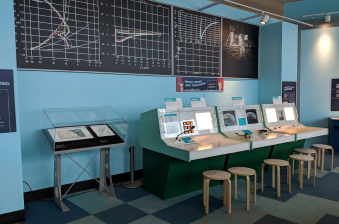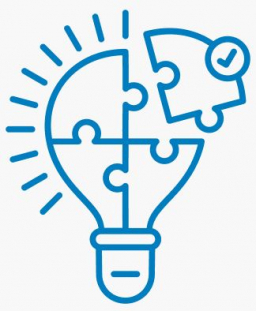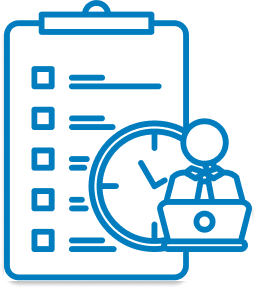Traveling Exhibitions: Finding the right match
![]()
Museum
![]()
Topics
Big Ideas
Choosing a traveling exhibit based on your organization’s unique needs and capacity
Affiliate advice on how to prepare for an incoming travel exhibit

EXHIBIT & AFFILIATE SPOTLIGHT
DESTINATION MOON at MUSEUM OF FLIGHT
A travel exhibition flexes to museum needs
Destination Moon: The Apollo 11 Mission is widely regarded as a blockbuster exhibit that explores the birth of the American space program and the space race. It features iconic objects, including Neil Armstrong’s Apollo spacesuit and the Apollo command module Columbia. Organized by the National Air and Space Museum and the Smithsonian Institution Traveling Exhibition Service (SITES), it toured from 2017 through 2020 before the objects returned to a new permanent gallery on the National Mall.



The Museum of Flight in Seattle hosted Destination Moon in 2019. Seth Margolis, Director of Education, describes the process of working with the Smithsonian as a collaborative effort. Because much of the Museum of Flight’s programming is highly interactive, there was a desire and need to personalize the exhibit to their institution.
Margolis describes receiving exhibit support materials, including a list of speakers, educational resources, and other materials, and having the freedom to use the resources in ways that worked for the Museum of Flight. “Rather than it being prescriptive, I was able to take the base of what was developed and overlay it with the way that we do education here; take the good ideas and apply them and expand on them, or sculpt and shape them into how we do programming. There was recognition that we do things differently than the Smithsonian,” says Margolis.
Destination Moon traveled to a total of five venues. SITES also made the Destination Moon poster exhibition available to other organizations at no cost.
The poster show, also developed by the National Air and Space Museum and SITES, draws content from the larger exhibition and offers a condensed yet insightful look into the Apollo 11 mission. It includes seven posters and downloadable educational materials, allowing museums, libraries, schools, and other organizations to engage with the historic mission. Both the traveling exhibition and the poster show allow organizations to connect with this significant era of space exploration in ways that align with their capacity and goals.
It set a good precedent of allowing the recipient’s voice to be part of the process. There wasn’t the expectation that the program would mirror what was done in DC; it would be evolved here to fit our needs.

The Museum of Flight
AFFILIATE ADVICE
Choosing a traveling exhibition based on your unique needs
01
Upfront, identify the traveling exhibition qualities that align with your organization’s needs and capacity.
Traveling exhibitions vary widely; before beginning an assessment, identify the needs of your organization based on capacity and other variables. “We have the bandwidth to personalize; other organizations may want prescriptive programming,” says Margolis. “Adopt or adapt; if you have the ability and resources to sculpt it, or the ability or need to adopt it.”
Smithsonian Institution Traveling Exhibition Service and Smithsonian Affiliations (SITES | SA), alongside our Affiliates, offer a wide variety of exhibits to accommodate a range of organizational needs, including traveling exhibitions, build-it-yourself exhibitions, and poster exhibitions. All exhibitions are designed to be displayed as-is or to be customized.
ORGANIZATION NEEDS TO ASSESS
- Space Requirements: Evaluate the floor area needed and whether the building can accommodate the exhibit’s physical dimensions and other facility requirements, such as security and temperature and humidity controls.
- Budget Constraints: Determine the overall costs, including shipping, insurance, installation, and potential staffing, programming or marketing needs.
- Audience Alignment: Consider if the exhibit aligns with your institution’s mission and would be of interest to your typical audience demographic or an audience you are trying to reach.
CURRENT PRIORITIES FOR TRAVELING EXHIBITION
- Educational Impact: How does the exhibit align with current educational goals and programming? Are there educational resources that can be integrated?
- Community Engagement: What are the strategies for community outreach and engagement? Can partnerships with local organizations be formed?
- Diversity and Inclusion: Does the exhibit promote diversity and inclusion? How can the exhibit contribute to telling a broader, more inclusive narrative?

02
Once you've narrowed it down, ask these questions to ensure the exhibition is the right fit.
Flow & Layout
- Beyond the object list, can you send me a sample layout to help me understand the flow?
Budget & Logistics
- What is the rental fee?
- Can I have it for an extended time; can that be prorated?
- What are the shipping costs?
- Are there other costs?
Audience & TakeawaYs
- What are the objectives?
- What should audiences walk away knowing or understanding?
Education & Marketing Readiness
- Is there an existing educational packet for staff and docents?
- Are there existing marketing materials?
- Is there a current gallery guide that we can print?
Interactivity
- Are there interactive elements included in the exhibition?
- Are they low-tech or high-tech?
- Does technology come with the exhibit?
- Does the venue have to provide any technology (monitors, etc.)?
References
- Who has already hosted this exhibit?
- What other museums can serve as a reference for this exhibit?



AFFILIATE ADVICE
Preparing for a traveling exhibit once you've signed the contract
Once you’ve signed a contract, determine how proactive you need to be based on the exhibit’s scale—then take early action.
Knowing that teams are always busy and that being proactive can be difficult, Margolis suggests thinking about how essential it may be to be proactive based on the scale of the traveling exhibit. “It’s always a flurry,” says Margolis. “But maybe it’s finding the scale—if it’s a poster exhibit, what does that mean, as opposed to receiving pieces that went to the moon? It’s finding the scale of proactiveness that’s needed.”
“The minute that contract is signed, start thinking about what it will mean for every nuance of the organization,” says Margolis. “What will it mean for volunteer training, for programming? What does it mean for your audience? Are there things you could do that will bring it to your audience in a way you haven’t thought of because it’s specifically at your museum? Otherwise, it will creep up on you.”

Don't just rely on the product—download with a person to learn about audiences and engagement.
“We are in an industry that is so based on engagement with people that hearing from someone else who engaged with people [in the chosen exhibit] is important,” says Margolis. “Hear from somebody who’s done it, like ‘here’s how we trained our docents to do the tours.’ Otherwise, we’re not passing on knowledge.”
Margolis also urges teams on the education side to identify someone they can ask questions—not necessarily a subject matter expert, but someone who has worked in education for that area. “For me, I know about lunar history,” says Margolis. “I’d love to talk to somebody about translating that into an audience. For an audience who is five years old and doesn’t understand the idea of 50 years ago—how does a museum like us spark that for them?”

Help all levels of staff be able to explain the exhibit and why it’s coming.
“The minute you sign that contract, start to generate buzz within the home organization,” says Margolis. “An exhibit may be slightly divergent from your normal topics, but explain why it’s there and why the museum decided to do it. Give everybody the elevator pitch so they have it in their back pocket. Everybody from the head of the board down to the newest volunteer gets that common viewpoint; whether it’s coming in a year or a month, everybody can speak to it.”

Learning Excursions
Take a deeper dive into what it means to be an Affiliate through these Learning Excursions. Use filter controls below to access content by type.

Essentials
Geared towards new and existing Affiliates, access modules to assess your organization’s:
- DEAI
- Community Engagement
- Vision for Engagement
- Collaboration and Relationship Building

Affiliate Stories
Modules to enhance your collaborative efforts, build leadership skills, and showcase your impact. Here you’ll find:
- Case studies
- Affiliate perspectives

Tools for Action
To facilitate ongoing learning and skill development, find:
- Reflection guides
- Toolkits
- Other resources
We’d love to hear from you!
Do you have a powerful story of successful community engagement or collaboration you’d like to share? Or do you want to connect and learn more about community engagement resources and supports?
Reach out to your National Outreach Manager. They’d love to connect and share ideas!


